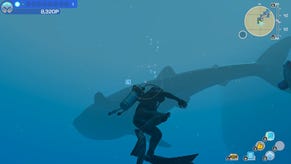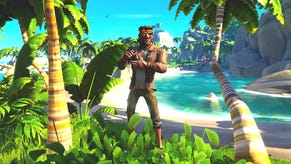This celebration of Runic Games' greatest hits is late because I was playing Runic Games' greatest hits
Farewell to one of the best.
The Mapworks is the heart of Torchlight 2. In many ways it feels like the heart of so much that is great in video games in general. You spawn at the portal and then you walk out, along a narrow golden bridge, to a magical clockwork escapement suspended in the void. I can imagine what the floor feels like here: the glossiness of the crystal and polished metal, and that hum coming up through your feet that suggests vast energies twisting and churning beneath you. The Mapworks is where you get to once Torchlight 2 is all but done, but it's also where you realise that Torchlight 2 is just beginning, and that it never has to end if you don't want it to. The campaign is over, and here, in this stately firmament, you can buy an endless supply of procedurally-generated maps that will take you to an endless stretch of procedurally-generated dungeons.
I went to the Mapworks a few weeks back when I heard Runic Games, the developer that made the Torchlight series, alongside this year's wonderfully intricate Hob, was closing down. The idea was to slip back into Torchlight 2 for a few minutes to remind myself of this team's particular greatness, and then slip back out again to write a quick piece about how much I would miss them and their work. The problem, of course, is obvious. The idea was to slip back into Torchlight 2 for a few minutes... So yes, this farewell to Runic Games is so delayed because I was playing Runic games. I cannot think of a better tribute, to be honest.
Anyway, let's begin this sad task. Here is my second-favourite bit of writing in Torchlight 2: "Flame Hammer". Flame Hammer is the go-to skill I rely on when playing my Engineer, a sort of steampunk pet-class who dashes into battle alongside a clanking, wheezing, skittering collection of Roombas and rollerskates that spit gatling fire and poison at anyone stupid enough to cross their path. Flame Hammer is far more fun than a basic attack in an action RPG should be. Flame Hammer is seismic. I could describe it, but why not quote the flavour text, which does a far better job of it than I could ever hope to? "Your weapon crushes foes it strikes--" All good so far. "--Creating 4 flaming splinters that seek out enemies within 5 meters. If available a Charge is consumed to generate two additional--" Whoa whoa whoa. That's quite enough of that. 4 flaming splinters! That seek out enemies! Within 5 meters!
So yes, it is quite nice to tool around in Torchlight 2 with a portable fault-line on the right mouse button. But what would Flame Hammer be without the glorious context Runic provides? A huge fantasy world, machines and magic toiling away, gears meshing, cogs rattling. An infinity of quests and things to smash to pieces on those quests. The tile sets really do not feel like tile sets: they feel like sunken grottoes, buried temples, haunted marshes. They are cliches, but that's the point. They're the kind of cliches that made you love gaming in the first place. Pirate caves where the sands are covered with toxic crabs and pathways made from the rotting skeletons of ancient frigates. Misty lanes that lead deep into spider territory. Icefields glinting with sharp malice.
And it was all there from the start with these guys. I remember talking to one of the founders of Runic at a PAX in Seattle many years ago. Torchlight 1 was yet to be released, and this founder - it was Max Schaefer, and he was an absolute delight - could simply not hide his enthusiasm for what his team was making. "We've got tile-sets, special tile-sets, weapon slots, weapons with sockets, armour with sockets..." It occurs to me now that this listing, this bubbling delight in features, in details, was the pressurised chatter of the newly freed. Several of the founders of Runic were fresh from disaster. Flagship Studios had just spent an age on Hellgate: London, an attempt to rework the Diablo template, which had not been well-received. Furthermore, their promising off-shoot, Mythos, had fallen out of their control. Since a core of Flagship could trace a lineage all the way back to Diablo itself, this is basically ARPG royalty we're talking about. And now they were planning their next move.
And Torchlight was quite a move. I first played Torchlight during the moment I was rediscovering the PC, and Torchlight seems sort of wrapped up in things that define the greatness of the PC as a gaming platform. Crucially, Torchlight, like Diablo, is both entirely simple and dizzyingly complex. You wander down a hole and hit skeletons. That's it, basically. But look at all the ways you can hit skeletons! Look at all the things you can hit them with! Look at all the clothes you can wear while you hit skeletons! Look at all the sockets in those clothes where you might want to slot a gem or two.
Man, Torchlight nailed all this stuff. It had the best skeletons I had ever hit: a crunchy, hollow, xylophone bone clatter as those guys come apart under my blows. It had the energising focus of a single location that just kept leading me deeper and deeper while the creatures knocking around the place got weirder and weirder. It had a class pretty much perfect for someone who wanted to go into battling conjuring spooks of various shapes and sizes, and it had that perfect ARPG churn: every moment was terribly important because look at these people exploding in front of my as I chug through them, but at the same time, nothing matters so much as what I'll be unlocking in the next twenty minutes and the loot I'll be harvesting an hour from now.
Torchlight 2 expanded on this, but if the first Torchlight had been a welcome return to the early days of Diablo, Torchlight 2 was both Diablo 2 - far-roaming and mysterious and generous - but also a glimpse of an alternate universe Diablo 3, made by people who had a claim to the lineage and were taking off in a direction that was both familiar and very different to what Blizzard was cooking up at the time.
The way I would put it is that if Diablo 3 was all about the skills, those wonderful sweet shop explosions that threatened to make everything else in the game, including loot, pretty much meaningless for a casual on their first race through the campaign, Torchlight 2 was about the skills in the context of that old-school number tray at the bottom of the screen. Loot mattered here, but so did the classic ARPG glissando, where you sale into a mass of chattering enemies, jam an imperious finger down onto 1 and then flick it to the right as fast as it will go. Diablo 3's skills were events in and of themselves in a way few other studios could hope to rival, but Torchlight 2 was all about being an arsonist in a firework factory. It didn't matter what was going off half the time, just that there were particles and gases and people on fire and ghosts and poison and dust in the air long after the monsters had ceased twitching. I'm talking as a casual here, of course, but the joy of a good ARPG is that it's two games in one at the very least, and one of those games is happy to welcome the cow-clickers and the Bejeweled refugees and show them bright lights and a bit of Liberace dazzle.
Over time, updates from Blizzard meant that Diablo 3 and Torchlight 2 would have one very important thing in common, too. They would both present end-games that were so ruthlessly clear-headed regarding the pleasures of ARPGs that it would be hard to see what the genre could do next. Diablo 3's adventure mode and Torchlight 2's Mapworks are both admissions that the story never mattered really, that the curation never mattered, and that levelling and the acquisition of new stuff is all the context an ARPG really needs for most people. Go!
So it sort of made sense, although it was very sad, that Torchlight 3 never seemed like it was on the way. Some of the team splintered off to a new studio and Rebel Galaxy, a fresh and fiercely enjoyable spin on some classic Diablo ideas. The rest of them made Hob, and Hob is a very different kind of ARPG, tracing a path from Zelda rather than Blizzard. This is the kind of ARPG where nothing is left to chance, and where the trajectory of the stats going up is secondary - secondary! - to the world map growing larger, to the relationship between different parts of that map becoming more complex and interesting.
God, Hob is a special game, intricate and heartfelt and retaining a real warmth despite the evident cleverness that defines this clockwork world. A world in which mountains twist about and drop from view, in which valleys flood to become rivers, in which a bubblegum corruption is cleared back one area at a time to reveal the clean brass and stone lying underneath.
And hey, that brass, that stone, that clockwork world can't help but remind me of the Mapworks, and then we're full circle again, but with a lesson learned: Runic's special genius was a mastery of the genres they tackled. And that mastery could be applied to genres that the team did not come with a history of already having worked on.
I don't know what went wrong. I never do. But what's heartening is that the games themselves did not go wrong. They are all great, and they are all ambitious and ingenious and human and generous. And while Hob is, by design, a finite adventure, a puzzle-box you can solve and then place back on the shelf to look at and feel smug about forevermore, Torchlight and Torchlight 2 keep going. You can head back in and lose yourself for another fortnight - as I think the untimeliness of this piece only proves.
And that leads me back to my favourite bit of writing in Torchlight 2. You're deep in the mines, or the grottoes, or the buried temples, and you're knee-deep in skeletons and epics and all manner of slithering horrors. You unleash Fire Hammer and those four splinters reach out, seek out, and do their damage within that five meter radius. The smoke clears and you're alone. Is this the end?
It is not the end. Because up ahead is a doorway and the hint of some descending steps. And then you see the magical words: "Stairs down."
Thank you so much for the great games, Runic, and best of luck for the future.









.jpg?width=291&height=164&fit=crop&quality=80&format=jpg&auto=webp)
_Rwmp6uD.jpg?width=291&height=164&fit=crop&quality=80&format=jpg&auto=webp)

